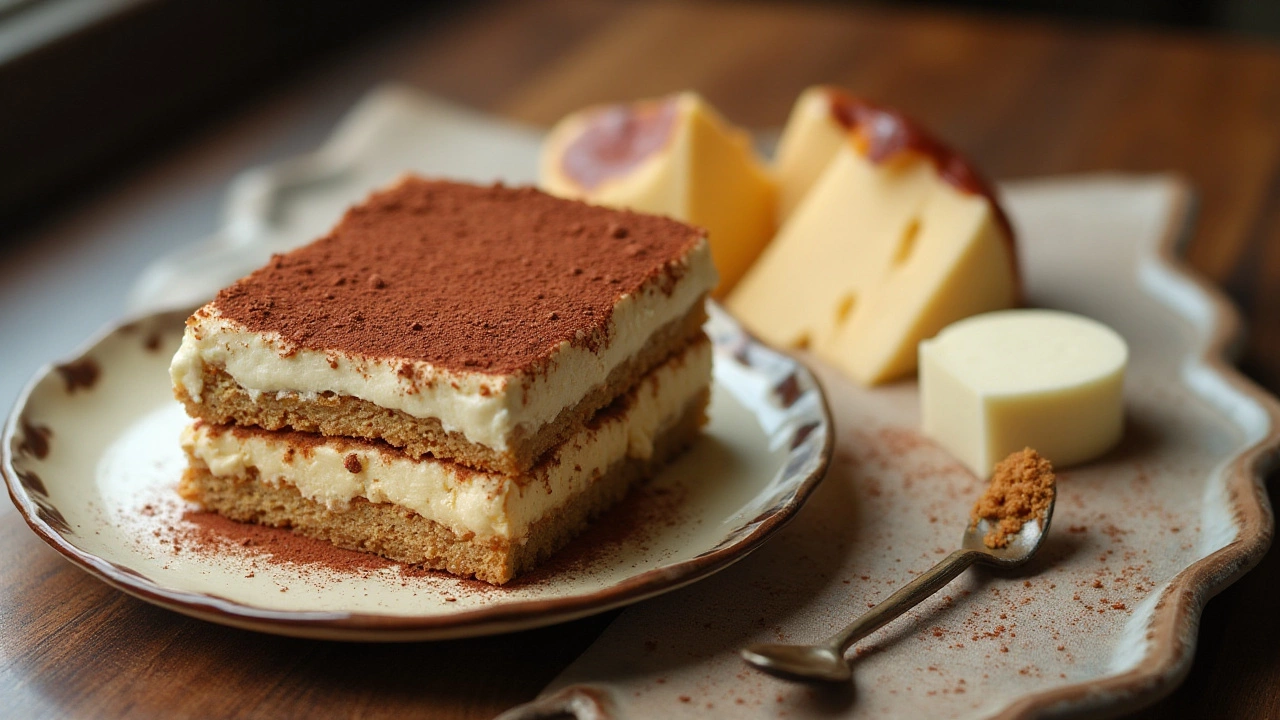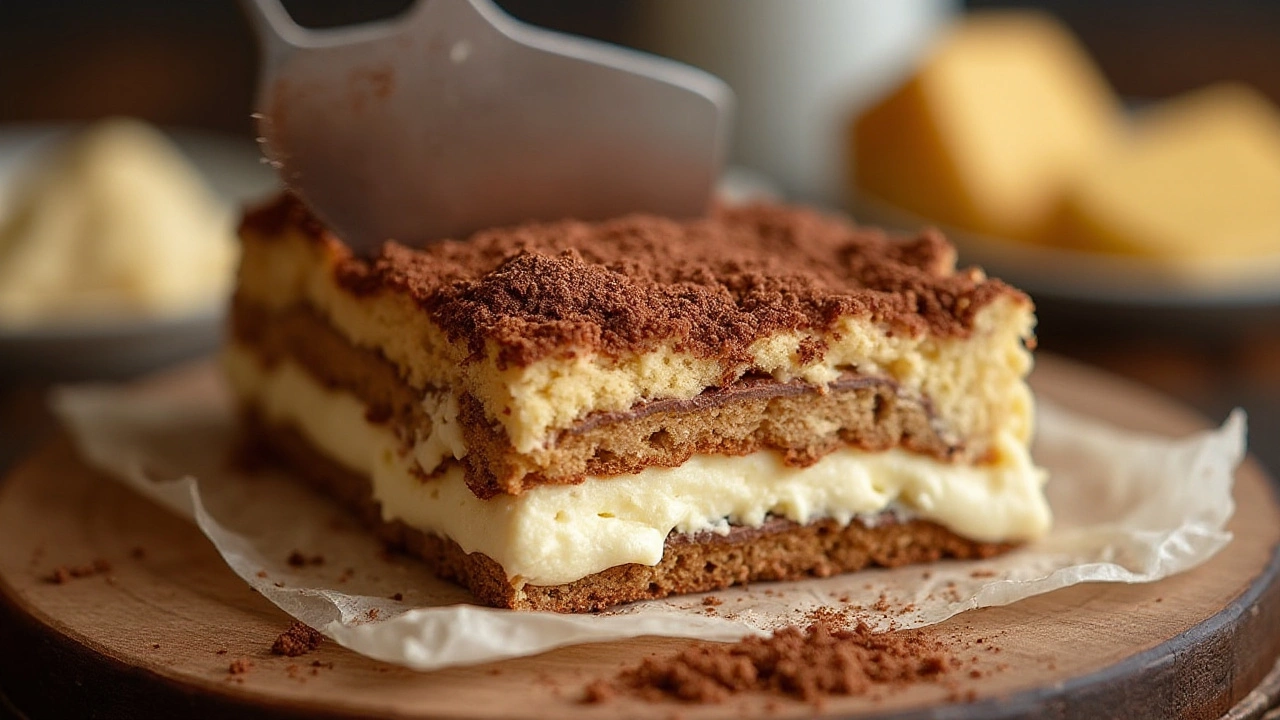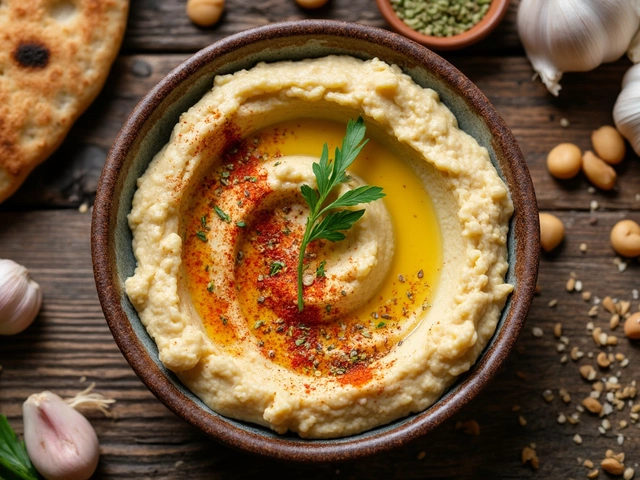
Tiramisu, beloved for its rich layers and creamy texture, has become a staple in dessert menus worldwide. A pivotal element in achieving its divine creaminess is the choice of cheese, traditionally mascarpone, which adds that unmistakable silky and rich flavor. But have you ever wondered if there’s room for creativity when it comes to the cheese selection?
In this article, we’ll explore the integral role that cheese plays in tiramisu, not just in flavor but in texture as well. We'll dive into why mascarpone has secured its place as the classic pick, yet also delve into potential substitutes that could inspire your next culinary experiment. Whether you are a seasoned chef or a home baker looking to impress, understanding these cheese options can elevate your tiramisu game.
- The Role of Cheese in Tiramisu
- Mascarpone: The Classic Choice
- Alternatives to Explore
- Tips for Selecting the Best Cheese
- Crafting an Unforgettable Tiramisu
The Role of Cheese in Tiramisu
The cheese in tiramisu serves as the backbone of this sophisticated Italian dessert's creamy texture and rich flavor. In its simplest form, tiramisu is a symphony of contrasts — light against dense, sweet against bitter, and soft against firm. The choice of cheese, typically mascarpone, ensures the cream layer binds these contrasts into a coherent gastronomic experience. Mascarpone, with its buttery consistency, plays a critical role in achieving that delicate equilibrium between layers. It provides a subtle flavor, almost like a blank canvas, that harmonizes beautifully with the boldness of espresso-soaked ladyfingers and the gentle sweetness of cocoa dusting.
Interestingly, while mascarpone is the most traditional choice, it wasn't always easy to come by when tiramisu first rose to fame outside Italy, particularly in the United States during the mid-20th century. Back then, creative bakers might have used cream cheese or even ricotta as substitutes, albeit these cheeses bring their own unique flavors and textures to the dish. The key lies in finding a cheese that complements tiramisu's existing elements without overwhelming them. It's this delicate balancing act that transforms a simple dessert into a textural masterpiece that's both light yet intensely comforting.
The famous culinary expert Nigella Lawson once remarked, "There is a sheer comfort in the simplicity of mascarpone; it's the quiet hero of the blend, allowing other flavors to whisper through." Meanwhile, Americans' love for experimenting with tiramisu ingredients has ensured that mascarpone alternatives such as heavy cream whipped with cream cheese proliferate in various forms of the dessert. Such adaptations reflect regional availability and dietary preferences, showcasing how tiramisu can be both personal and diverse.
In refining your tiramisu, one might consider comparing nutritional contents — an area that often escapes the spotlight. A comparison of calorie content between cheeses could potentially influence choice where dietary considerations come to play. For instance, mascarpone contains about 450 calories per 100 grams, whereas ricotta offers a lighter alternative at roughly 174 calories for the same quantity. Here's a brief look at the nutritional differences:
| Cheese Type | Calories (per 100g) | Fat Content |
|---|---|---|
| Mascarpone | 450 | 44g |
| Ricotta | 174 | 13g |
| Cream Cheese | 350 | 34g |
These numbers can be quite revealing, particularly if health or dietary restrictions shape your culinary journey. They underline the versatility of tiramisu's cheese component and hint at the bold or subtle adjustments one could make while retaining the dish's quintessential essence. Ultimately, the best cheese for tiramisu should meet the individual diner's expectations, harmonizing with other ingredients to produce a memorable and delightful dessert.
Mascarpone: The Classic Choice
When it comes to crafting the perfect tiramisu, the traditional choice of cheese is without a doubt mascarpone cheese. This velvety cheese, originating from the Lombardy region of Italy, is synonymous with tiramisu's characteristically luxurious texture. Its creamy consistency is a result of being made from just two ingredients: heavy cream and citric or acetic acid. This produces a rich, spreadable cheese that is not acidic, distinguishing it from counterparts such as cream cheese.
The subtle sweetness of mascarpone complements the bold flavors of coffee and cocoa, two other essential components of tiramisu. Because mascarpone holds its shape well and melts smoothly into a creamy mixture, it serves as the perfect binding agent between the layers of coffee-soaked ladyfingers and the dusting of cocoa powder. In many traditional Italian kitchens, mascarpone cheese in tiramisu is considered non-negotiable, elevating the dessert to its iconic vanilla-tinged heights.
"Mascarpone's luxurious texture is what makes tiramisu a taste of heaven," says famous Italian pastry chef Gianluca Fusto, emphasizing the irreplaceable quality of this cheese in achieving an authentic dessert experience.
The unique quality of mascarpone is not only in its taste but also in its ability to absorb flavors without overpowering them. This characteristic allows the mascarpone to meld seamlessly with the coffee, often espresso, and the liqueur, typically marsala or rum, that are used in traditional recipes. By gently folding mascarpone into sweetened egg yolks and whipped cream, an ethereal cream is created, forming the luscious layers for which tiramisu is celebrated. Each spoonful becomes a harmonious blend of bitterness from the coffee, sweetness from the sugar, and richness from the mascarpone cheese.
Choosing mascarpone that is fresh is crucial. Some experienced chefs suggest seeking out locally made mascarpone instead of store-bought versions that may include additional stabilizers affecting the final texture. It’s also worth noting that mascarpone cheese should always be refrigerated and consumed within a few days of opening to retain its freshness and flavor integrity. The slight sweetness that mascarpone adds is balanced perfectly with the bitterness of cocoa and coffee, making it the centerpiece of any tiramisu encounter.
Why Mascarpone is Irreplaceable
While it’s tempting to experiment with other cheeses for this dessert, mascarpone remains irreplaceable due to its unique properties. The cream cheese alternative might offer a similar visual appeal but lacks the nuanced flavor profile that mascarpone naturally provides. Where cream cheese may introduce a tangy note, mascarpone retains a luxurious, neutral creaminess. In fact, many experienced pastry chefs and Italian nonnas alike agree that a tiramisu without mascarpone is simply not a tiramisu.
With its origins deeply rooted in Italian culinary tradition, mascarpone is more than an ingredient; it's a testament to the elegance of simplicity in Italian cuisine. Respecting this tradition ensures that as variations of tiramisu emerge, the classic richness and creaminess remain undisputed. For those seeking a genuinely authentic tiramisu, mastering the incorporation of mascarpone is essential, as its delicate texture and taste offer an unparalleled culinary delight that transports one to the heart of Italy with every bite.

Alternatives to Explore
While mascarpone cheese is the undeniable champion in the classic tiramisu recipe, there are several other cheeses that can offer intriguing flavors and textures. Exploring these alternatives not only gives you a new perspective but also allows for creative adaptations that cater to different dietary needs or taste preferences. One such alternative is the use of cream cheese, which although tangier and denser compared to mascarpone, can create a firmer texture in the dessert. If you're aiming for a more balanced sweetness, consider this option, as it pairs surprisingly well with the coffee and cocoa elements in tiramisu.
Another interesting choice is ricotta cheese. Known for its lighter texture, ricotta can infuse airiness into the layers of the dessert, making it less dense and heavy. This cheese is particularly appealing to those who prefer a more subtle sweetness and a fluffy consistency. You might need to blend it well to achieve a smooth texture, but the end result can pleasantly surprise anyone looking for a healthier twist on traditional tiramisu. As a tip, your culinary adventure can be taken a notch higher by combining ricotta with mascarpone for a hybrid experience.
For those looking to venture beyond the traditional Italian options, goat cheese occasionally garners attention. This cheese, with its distinct tangy flavor, offers a completely new tasting experience. While it might sound unconventional for a dessert, when used sparingly, it can introduce a savory undertone that enriches the typical flavor profile of the tiramisu. However, this choice calls for a refined palate and is recommended for those open to culinary experiments.
In a world where dietary preferences and restrictions are increasingly at the forefront, vegan alternatives like cashew cheese have emerged. Made from blended cashews with added cultured elements, this cheese provides a creamy texture that can closely mimic mascarpone while being entirely plant-based. For your vegan friends or family members, this option enables them to enjoy tiramisu without compromise, though it may require some tweaks in the preparation process to match the original's flavor and consistency.
To add valuable insights into this discussion, food critic Anne Meredith from The Culinary Times once said:
"Playing with different cheeses is like discovering a new language of flavor. It gives the humble tiramisu an innovative twist while respecting its Italian roots."Her statement highlights the endless possibilities when one steps outside the traditional boundaries set by the recipe's heritage.
When considering substitutions, remember the importance of balancing flavors and textures. Creating a delicious tiramisu lies in understanding how these elements work together. Whether it's making a cheese swap to cater to specific dietary needs or just experimenting with non-traditional flavors, these alternatives provide plenty of avenues to explore, ensuring that your tiramisu remains a delightful dish loved by all.
Tips for Selecting the Best Cheese
Choosing the right cheese for your tiramisu can make all the difference between a good dessert and a great one. The classic choice, as you might know, is mascarpone cheese, celebrated for its creamy texture and subtle sweetness. However, there are a few key aspects to consider if you wish to either stick to tradition or break the mold. First, ensure the cheese is fresh. Freshness not only affects the taste but also the texture, which is crucial in maintaining the integrity of the layers in your dessert. When selecting mascarpone at the store, look for smooth texture without any separation of liquids, as this indicates freshness and quality.
Texture is just as important as flavor when it comes to cheese selection. With tiramisu ingredients, balance is key. The creamy consistency of the cheese should harmonize with the softness of the soaked ladyfingers, creating a delightful mouthfeel. If you’re feeling a bit adventurous, consider mixing mascarpone with a small amount of ricotta for a slightly different texture. This can add a touch of uniqueness to your classic tiramisu, and it’s a popular modification among some chefs. It is essential to taste the cheese before using it to ensure it complements other ingredients well.
Another tip is to mind the cheese's fat content. High-fat cheeses like mascarpone naturally create a richer, more indulgent dessert. However, for those seeking lighter options, swapping half of the mascarpone with reduced-fat cream cheese can still deliver a delightful experience while cutting down on the richness. Be cautious though, as changing fat content drastically can alter how the cheese behaves when incorporated into the mixture. It’s all about striking a balance between health priorities and taste satisfaction.
"The best cheese is one that's not struck by mediocrity but dances on the palate whimsically," remarked celebrated chef Massimo Bottura, highlighting the importance of cheese selection in gourmet dishes.
Finally, don't be afraid to experiment with blends. Some artisan cheeses mixed slightly with mascarpone can introduce new flavor profiles that might just become your signature touch. A hint of goat cheese, for example, can lend a slight tartness, balancing the dessert’s overall sweetness beautifully. Remember, taste is subjective. What pleases one might not please another, so always keep your audience in mind. For those cooking for children, sticking to traditional mascarpone might be safest, whereas adults might appreciate a more complex cheese character.
To sum it up, when selecting cheese for tiramisu, consider freshness, texture, fat content, and flavor balance. Whether sticking close to tradition with mascarpone or venturing into bolder combinations, these factors ensure your tiramisu not only pleases the eye but captivates the palate as well. Happy cheese hunting!

Crafting an Unforgettable Tiramisu
When it comes to tiramisu, the devil truly is in the details. This Italian dessert, renowned for its balanced combination of flavors and textures, can be surprisingly versatile. While traditional recipes adhere closely to classic techniques, there's a world of opportunities for those looking to put their unique twist on this beloved dish. A crucial aspect that cannot be overlooked is the role of cheese, where mascarpone often stars. Ensuring the cheese is fresh and at the right temperature can transform your tiramisu from good to unforgettable. Fresh cheese will blend seamlessly with the coffee and cocoa notes, creating that signature velvety layer that tiramisu lovers cite as the soul of the dessert.
When preparing mascarpone or any substitute, it should be worked into a creamy consistency, avoiding lumps which can affect the dessert's texture. It’s fascinating how expertly chosen cheese not only elevates the flavor profile but also complements other ingredients, like espresso-soaked biscuits and finely sifted cocoa. Precision is key, and the harmony between sweet and savory in tiramisu hinges on the cheese's quality and handling. Several culinary experts emphasize this point. As famous Italian chef, Lidia Bastianich once mentioned, "The perfect tiramisu is about balance. The cheese should not only be velvety; it must bring out the best of its co-stars."
For an unforgettable tiramisu, it’s also essential to layer the components skillfully. Whether you opt for a classic presentation in a rectangular dish or choose to impress with individual servings, visual appeal adds to the overall dining experience. Start by soaking ladyfingers just enough to imbibe them with espresso; too much liquid and they’ll become soggy, too little and they’ll end up dry. Spread the cheese mixture generously between layers, smoothing it to an even finish. Achieving the correct layering helps the tiramisu stand out not just in flavor but also in its striking appearance.
Let's talk a little about enhancing the flavors. Introducing subtle accents like a hint of liqueur or finely grated dark chocolate can add depth without overshadowing the distinctive characteristics of tiramisu. Balance and restraint in flavor enhancement are important, as tiramisu is known for its harmony. In a surprisingly easy twist, introducing a layer of fruit like ripe berries or citrus zest can infuse a refreshing contrast to the traditionally rich recipe. These elements, while non-traditional, can also add a pop of color, making your tiramisu not only taste incredible but look the part too.
Cheese tips for tiramisu extend beyond taste and touch on the practical aspects of preparation. It's advisable to chill the tiramisu for several hours or overnight, which allows the flavors to meld intricately and the structure to set. This waiting period is an exercise in patience as it ensures your dessert will slice cleanly and hold its shape beautifully, a reward for both the chef and the eventual diner. A little patience and care in choosing and preparing cheese can elevate your tiramisu to an unforgettable culinary experience, admired for its artistry and savoriness alike.





